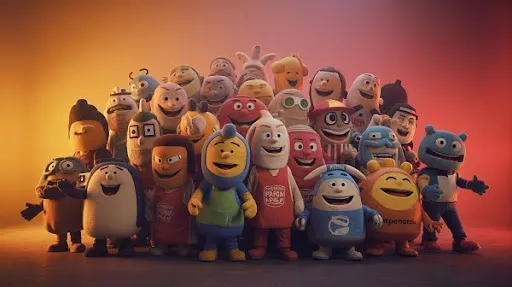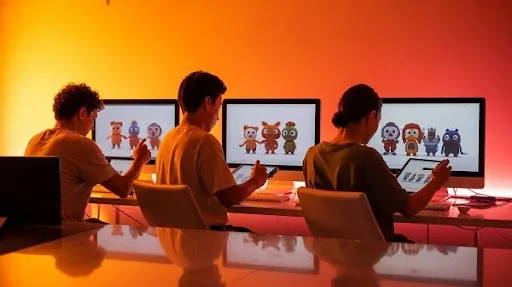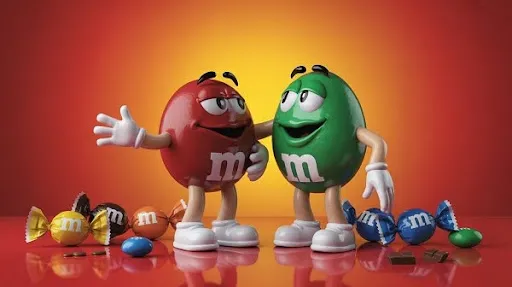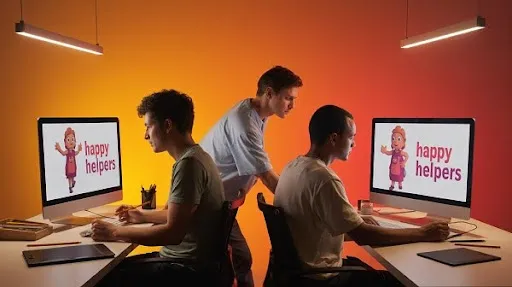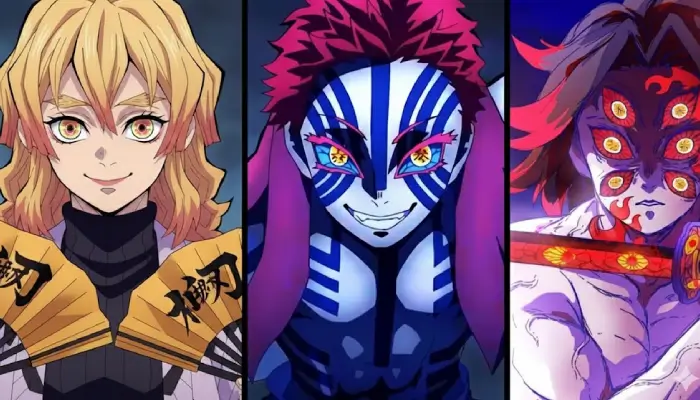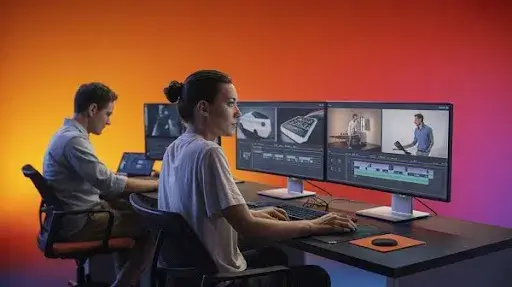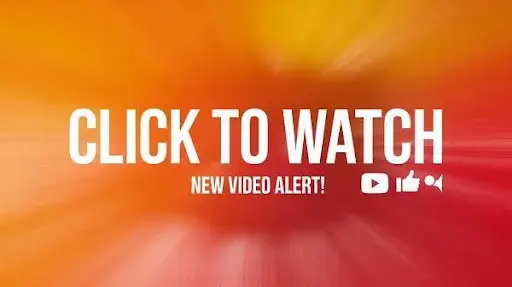Logos fade. Taglines slip through the cracks. But a character with a grin, a voice, or a weird little habit? That sticks. That’s the pull of a brand mascot. It’s not decoration. It’s a face people grow familiar with, the one that does the talking when the brand itself feels too stiff.
Think about it—those animated figures you’ve bumped into in ads or scrolling TikTok. You probably remembered the brand without even seeing the logo. That’s because a mascot doesn’t shout like an ad. It hangs around like someone you already know.
So here’s the real question: how do you create a brand mascot that works? And why are companies throwing serious money at them instead of just polishing their logos? Time to unpack that.
What Is a Brand Mascot?
A brand mascot is a character built out of a person, an animal, or even a product that takes on a personality. Unlike a static logo, this one can smile, sulk, wave, or roll its eyes. That movement makes it a bridge between your company’s message and the way people prefer to connect.
Look at Colonel Sanders for KFC, Mailchimp’s Freddie, or the chatterbox M&M’s. None of them sits quietly in the background. They laugh, talk, and carry the brand’s vibe.
So, if someone asks what is a brand mascot? The short answer is simple: it’s the character that makes your brand feel alive.
Fact: Campaigns that include mascots demonstrate significant improvements—36.7% rise in market share, 30.7% profit increase, and 28.1% growth in new customer acquisition compared to those without mascots.
Why Do Brand Mascots Work?
Because people don’t remember faceless companies the same way they remember personalities. Characters feel like friends. Familiarity grows, and trust tags along.
Over time, it’s not just the product your audience recalls—it’s the character. That silent connection is why mascots push recognition higher and keep people engaged.
And they’re not boxed into ads anymore. Mascots can swap into holiday outfits, jump into trending videos, or even show up in VR experiences. Once you give them a personality, they’re free to live across platforms—classic transmedia storytelling in action.
How to Create and Design a Brand Mascot
A mascot isn’t a doodle you slap on packaging. It’s a spokesperson. A long-term one. Building it takes layers of thought, creativity, and strategy.
Step 1: Start with the Concept
Before a single sketch, you need the big idea. Three pieces matter most:
- Visual cues: Shapes, colors, and posture that instantly echo your story.
- Persona: Traits that line up with the audience you’re speaking to. Playful crowd? Build playful energy. Serious market? Dial it back.
- Psychology: Treat the mascot like an ambassador. How it smiles, talks, and reacts has to mirror your values.
This isn’t just about figuring out how to create and design a brand mascot. It’s about deciding how you want your brand to feel every single time that character shows up.
Step 2: Drawing and Sketching
Now the pencils (or tablets) start moving. Artists play around with rough shapes, oversized gestures, and exaggerated lines.
Circles give off friendliness. Sharp edges feel confident. Loose strokes can hint at humor.
The point isn’t perfection—it’s discovery. Sketching is where personality starts to peek through.
Step 3: Personification
This is where the fun starts. A sketch gets quirks. Suddenly, it has a soul.
- Colors: Warm shades invite. Cool tones calm. Each choice has weight.
- Accessories: A hat, sneakers, or glasses add personality.
- Expressions: A grin or a raised eyebrow can speak louder than a slogan.
- Outfits: Seasonal tweaks—like a winter coat or Halloween cape—keep the mascot fresh.
- Environments: Drop the mascot into daily-life settings to make it feel part of your audience’s world.
Done right, the mascot stops being “artwork” and turns into “someone.”
The Three Main Types of Brand Mascots
Most mascots fall into one of three groups.
Human Mascots
Plenty are based on founders, spokespeople, or fictional characters. Colonel Sanders is the perfect example. Human mascots hit home because they look like us, so the connection is natural.
Animal Mascots
Animals come loaded with symbolism. A tiger oozes strength. A bird signals freedom. A chimp brings playfulness. Twitter and Mailchimp nailed it here.
They can also tie straight to products—a cow for dairy, a bee for honey, a fish for seafood. It’s an easy, timeless match.
Object Mascots
Sometimes the product itself gets a voice. M&M’s candies turned into a group of loudmouths. Michelin’s pile of tires became a full-blown character. Objects only work when they’re given a full backstory—but when they are, people stop seeing them as objects at all.
Famous Mascots That Won Big
Some mascots didn’t just sell—they became cultural staples.
- M&M’s Talking Candies: Each color with its own quirks, perfect for endless campaigns.
- Duracell Bunny: Energetic and unstoppable, exactly what batteries promise.
- Firefox Fox: Friendly, bold, and easy to rally behind.
These weren’t random drawings. They were stories in character form.
Brand Mascot in Social Media
Nowhere do mascots shine brighter than online. Logos fade into the feed. Characters jump out.
Here’s why mascots are gold on social platforms:
- They show personality: Every post feels like it’s coming from a character, not a faceless brand.
- They spark replies: People comment as if they’re talking to someone real.
- They stretch reach: Memes, GIFs, reels, and AR filters give them more life than a logo ever could.
- They stay loyal: Influencers may juggle sponsors. Your mascot never leaves.
This is where companies like Prolific Studio stand out. With 3D video animation services, mascots don’t just exist—they move, they talk, and they fit any platform you throw them on.
Designer vs. Agency: Which Brand Mascot Service Works Best?
Plenty of businesses start with freelancers because it looks cheaper. The snag? Mascot design isn’t a single-task job.
A sketch artist may deliver neat drawings but struggle with animation or brand consistency. Juggling multiple freelancers usually means the character feels stitched together.
An agency that offers brand mascot service solves this. You get illustrators, animators, writers, and strategists working in sync. The end result isn’t just a drawing. It’s a brand personality built to live for years.
If you want a mascot that lasts and scales with your campaigns, a full studio is the safer move.
Understanding the Success of Brand Mascot Creation
Launching a mascot isn’t the finish line. It’s the kickoff. Once that character becomes part of your brand, you need to know if it’s actually doing its job. A mascot isn’t decoration—it’s a marketing tool, and tools are supposed to deliver results.
So how do you check? Start with recognition. If customers recall the mascot quicker than the logo, that’s already progress. Then look at engagement. Mascot-led posts on social platforms often get more comments, likes, and shares than plain product shots.
Customer feedback also matters. Surveys and focus groups tell you if the mascot’s personality feels right or misses the mark. And of course, the most obvious measure—sales. If sales rise after a mascot-driven campaign, the link is clear.
In short, mascots aren’t just cute ideas. Their impact can be tracked.
Avoiding the Pitfalls in Brand Mascot Creation
Plenty of mascots flop. They show up with energy, fade fast, and vanish. Why? Because of mistakes that could have been avoided.
The first mistake is inconsistency. A character that acts goofy in one ad and serious in another feels confusing. Mascots should stay in character across every channel.
Another trap is overdesign. Too many accessories, too much detail, and suddenly the mascot is hard to recognize. The strongest mascots are usually simple.
Then there are cultural blind spots. Something funny in one region might not land well somewhere else. Testing across different audiences keeps brands out of trouble.
And let’s not forget stagnation. Mascots need updates over time—new clothes, minor redesigns, seasonal touches. Small refreshes keep them relevant without stripping away identity.
Getting these right helps any brand mascot service build characters that stick around for the long run.
The Future of Brand Mascots
Mascots aren’t a throwback. They’re evolving with technology and finding new roles.
Some brands now use mascots as chatbots powered by AI, handling simple customer questions. Others place them in AR or VR, where they interact with people in real time.
Storytelling also goes beyond ads. Through transmedia storytelling, mascots can appear in short films, mobile games, TikTok challenges, or Instagram reels. They stop being just “faces” and become personalities audiences follow.
Some mascots are even gaining their own fan bases as virtual influencers. And unlike human influencers, a mascot doesn’t switch teams—it’s tied to your brand permanently. That loyalty has serious value.
The next generation of mascots won’t just look like cartoons. They’ll feel like characters people know and interact with every day.
Significance of Brand Mascot Design Portfolio
If you’re planning to create a mascot, the smartest move is to check the design portfolio of the studio you hire. A portfolio shows whether the team only makes attractive drawings or actually builds characters that work in campaigns.
At Prolific Studio, one of the best animation studios in Georgia, for example, the portfolio includes everything from playful food mascots to bold animal figures. But the real proof isn’t just how they look—it’s how they performed. Some boosted recognition, others fueled viral campaigns, and many became recognizable figures for years.
That kind of track record is what you need to see before trusting a studio with your brand mascot creation.
Frequently Asked Questions
What is a brand mascot, and why does it matter?
It’s a character that represents your business. Unlike a logo, it has a personality that people remember.
How long does brand mascot creation take?
Anywhere from a few weeks to a few months. It depends on the concept, design, animation, and testing.
Can mascots work for small businesses?
Yes. Even small shops or local services can use mascots to stand out. You don’t need a massive budget—just a relatable character.
How do mascots perform on social media compared to logos?
Mascots usually get more interaction. People engage with them as if they’re real personalities.
What’s the benefit of hiring a studio over freelancers?
A freelancer may deliver artwork, but a 2D animation production company provides consistency, long-term scalability, and strategy.
Which industries use mascots the most?
Food and beverage, retail, entertainment, consumer goods, and tech. But really, any business that wants recognition can benefit.
Final Word
A logo can open the door, but a mascot gets people to stay. From social buzz to brand loyalty, mascots create recognition that lasts longer than campaigns.
The brands that succeed treat mascots like ambassadors, not side projects. They track performance, refresh them when needed, and let them grow with the audience.
If you’re serious about making your brand memorable, now’s the time to act. At Prolific Studio, our team creates mascots through both 2D and 3D animation—characters built to connect, engage, and evolve with your business.
Your competitors may settle for a polished logo. You can give your brand a living, breathing personality.
Related articles:

